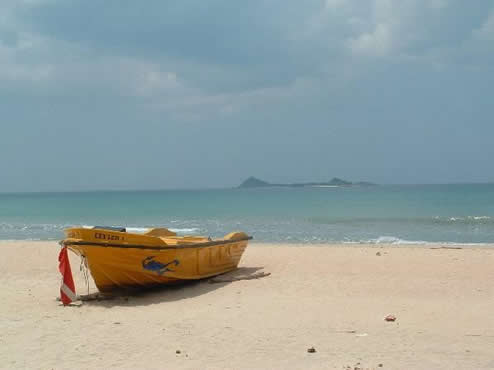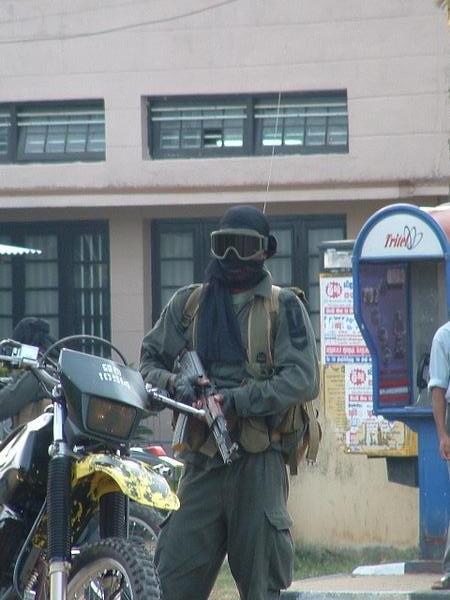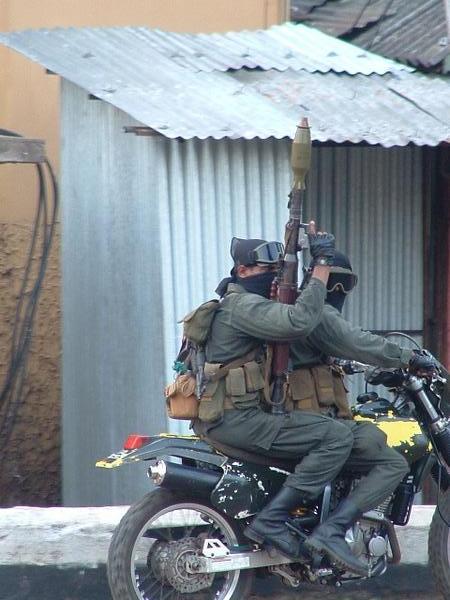Civil War in the Jungle
The Demons that Stalk Sri Lanka
by The Independent, UK, May 3, 2006
|
[Except for ignoring the hundreds of Tamil civilians killed in the past few months, this article is a reasonably accurate representation of the situation. --Editor]
|
The guide books say the beach at Uppuveli is the finest on Sri Lanka's east coast. The setting is the stuff of tropical island paradise, a graceful curve of white sand with palm trees leaning over it, and emerald water as far as the eye can see. But today the beach is covered in discarded rubbish. The hotels and beach huts are empty and boarded up, no tourists come here any more. As evening falls menacing packs of dogs roam the empty beach.

Nilaveli, just north of Uppuveli, photo by tourist Jason Brown |
It has nothing to do with the tsunami that devastated Sri Lanka's beaches a year and a half ago. A different disaster is looming over Sri Lanka: a man-made disaster. The tourists are not coming here any more because Sri Lanka seems to be slipping inevitably back into civil war.
Tourists still flock to the other side of the islands, to the beaches of the south and west. You can still eat freshly grilled fish at a table on the water's edge, while the waves wash over your feet, or drink the water from a bright orange king coconut while you float in the Indian Ocean, or doze under a palm tree as the sun slowly sinks into the waves. The tsunami is a thing of the past, and paradise is back in business. But all the while there is an air of impending disaster.
If you drive through the jungle in the east, you can see herds of wild elephants crossing the road. Long-tailed monkeys watch you go by from the trees. At night, fireflies hang by the roadside, and green snakes are caught in the car's headlights as they slither across the tarmac. This is the unspoilt Sri Lanka tourists flock from around the world to see.

Buddha's Army, Trincomalee, June 9, 2005, photo by tourist Jason Brown |
But these days even the elephants are on edge. They watch as Sri Lankan soldiers set fire to the foliage they feed on. The fires burn through the night and send blinding columns of smoke into the sky. The army is trying to clear the roads of hiding places for Tamil Tiger guerrillas, so they are burning the unspoiled jungles of Sri Lanka.
The tsunami on Boxing Day in 2004 was a defining moment. There was no compassion fatigue, the world shared in Sri Lanka's tragedy. The relief camp built for tsunami survivors just outside Sampoor village is full again. But this time it is sheltering people who fled air strikes on their village last week, more than 10,000 of them, using the makeshift lavatory facilities put up by international NGOs for those made homeless by the tsunami.
"I was in my house with my husband," says Nadaraja Parthipillai. "I heard a huge noise. My neighbour's house was hit, the Nahaiyas', and the whole family was killed, all 10 of them. Four of them were children. After we saw that we just started running and came here." Ms Parthipillai and her husband sleep in the open under the shelter of a palm tree. Like everyone else here, they say they are too scared to return home, afraid of more air strikes. At least 12 people died in the village last week. But Sampoor is not just any Sri lankan village. It lies inside territory controlled by the Tamil Tigers, right on the frontline.
At least 64,000 people died during the two-decade war between the Liberation Tigers of Tamil Eelam (LTTE) and government forces, before an uneasy ceasefire was negotiated in 2002 by Norwegian mediators. That ceasefire has been slowly crumbling this year, until this week the European mission that monitors it admitted that while it is still technically in force, on the ground there is no longer a ceasefire.

Trincomalee, June 9, 2005, photo by tourist Jason Brown |
The air strikes came after months of attacks on Sri Lankan security forces using remote-controlled mines and grenades, which culminated in the attempted assassination of the army chief by a female suicide bomber last week. The heavily pregnant woman entered the army headquarters in Colombo with explosives strapped to her body. Once inside, she detonated the bomb. At least eight people were killed, and the army chief is still in a serious condition.
Though they have strenuously denied responsibility, suicide bombing is the calling card of the Tamil Tigers. Long before Osama bin Laden or Hamas got in on the act, the Tamil Tigers were the militant group thatfirst used suicide bombers deep inside their target's territory.
The attack was just the biggest in a series of strikes on Sri Lankan security forces. Last month, two British tourists were injured during a mine attack on a navy bus. The driver of the bus was killed, and it veered out of control into the minibus in which the Britons were travelling.
Every time the violence has begun to calm, there has been a new attack. Sri Lanka called off air strikes on Sampoor last week under intense pressure from its giant neighbour, India. But within days there were new attacks. On Monday, a remote-controlled mine exploded in Trincomalee's city centre. The target was a naval patrol, but a tuk-tuk auto-rickshaw bore the brunt of the blast, and four civilians were killed, as well as one sailor. It seems someone wants the violence to keep intensifying.
The Tigers deny responsibility for the attacks, but everyone in the diplomatic and aid community in Sri Lanka is convinved they are behind them. The international community has been trying all year to bring the two sides together for talks. At one point, they met in Geneva, in the first serious peace talks for years. But the Tigers have been refusing to travel to a second round of talks, citing government restrictions on their commanders travelling to meetings.
Crossing from government-held territory to the Tiger areas is a tense affair. At the front lines, barbed wire snakes across dusty fields. There is a government checkpoint with nervous soldiers. Then a short no-man's land, and you are inside Tiger territory.
There are only dirt roads inside the Tiger enclave at Sampoor, and there is little food - Sri Lankan journalists insist on loading up on biscuits before making the crossing. But the tiny enclave, only a few square miles, is fully administered by the Tigers - including a courthouse and government offices. And, amid the fields and bomb-damaged buildings, fighters in the tiger-stripe camouflage of one of the most effective guerrilla forces in the world. The Tigers have been fighting for more than two decades for a separate homeland for Sri Lanka's Tamil minority in the north and east of the country, saying they are discriminated against by the Sinhalese majority. At its height during the civil war, the LTTE controlled large areas of Sri Lanka, including the cities of Jaffna and Batticaloa. That is now reduced to a portion of the north, plus small enclaves, such as this, in the east.
The Tigers have carefully nurtured their mystique. Every guerrilla fighter is issued with a cyanide suicide capsule the day he is accepted into the Tigers' military ranks - to take if he is ever captured alive. Suicide bombings, carried out by an elite unit known as the Black Tigers, have been at the heart of the Tigers' extraordinary effectiveness as guerrilla fighters.
Puli Kutty's ambition in life is to become a suicide bomber. Just 22 years old, he already wears the tiger-stripe uniform of the LTTE. He joined the Tiger ranks as a child soldier, at 14 - the Tigers say they do not recruit children any more, but international NGOs have accused them of continuing to do so. He says his three brothers were killed by Sri Lankan government forces. Puli Kutty is not his real name, it means Son of the Tiger. "I am ready for death," he says. "When I die I expect Tamil Eelam for our people one day." Tamil Eelam is the name the Tigers have given to the homeland they seek.
Talking to Puli Kutty is unsettling. There is none of the talk of a guaranteed place in heaven for martyrs you hear from Muslim suicide bombers. He says he is not religious and believes that there is nothing after death. "When I make a suicide attack, only one person can inflict major losses on the enemy," he says calmly. "If we fight conventionally, we will lose several people to inflict the same losses.
There is a sort of fanaticism to the young man, he is utterly devoted to the cause. The only proviso he makes is that he would not want children to die in any suicide bombing he carries out.
The head of the Tigers' political wing in Sampoor, S Elilam, does not shed any light on why Sri Lanka is lurching back towards civil war. He sticks to the official line: the Tigers have not been involved in any of the attacks. "We have not broken the ceasefire," he insists, "we are maintaining the ceasefire agreement. It was broken by the Sri Lankan government. One army commander was injured and the Sri Lankan government is targetting the entire Tamil people with these air strikes," he says. "The LTTE has a right to defend the lives of Tamils. The government is there to defend the Sinhalese, so who is going to defend the Tamils?" On the drive back from Sampoor, a huge tree is burning, the victim of a grenade attack only minutes before I passed by.
JehanPerera of the National Peace Council, a widely respected Sinhalese peace campaigner, says there is "absolutely no doubt" the Tigers are behind the attacks on the Sri Lankan military. "The slide back towards war is primarily because of the LTTE's loss of confidence that it can achieve its objective through peace talks," he says. "They say they have met six or seven times with the government but the talks have yielded nothing. So they have gone back to what brought them the best results: military strength." The Tigers have reduced their original demand for an independent homeland to autonomy within a federal Sri Lanka, but the government has refused to countenance it. Mahinda Rajapaksa, the Sri Lankan President, was elected last year on a promise not give in to Tiger demands.
"What the LTTE is trying to achieve from the current violence is either to provoke a full-scale war, or to make the cost of a military campaign so high for the government that it will give in to their demands," says Dr Perera. In particular, the Tigers are demanding the government reins in the activities of a breakaway Tiger faction led by Colonel Karuna - it is an open secret in Sri Lanka that the government is supporting his renegade faction against the Tigers. Col Karuna, which is the nom de guerre for Vinayagamoorthi Muralitharan, is formerly the Tigers' most senior field commander and represents a real threat to Tiger security.
In a full-scale war, the Tigers may well believe they can win back the major towns they once controlled, Jaffna and Batticaloa.
"The present situation can't continue," says Dr Perera. "The only option the government has is to strike the LTTE at its roots, and that means war. I guess there is another option, for the international community to find some way to put pressure." With the violence intensifying by the day, the future looks bleak for paradise. The repercussions of the violence in the east are already being felt along the beach resorts of the south and west. As the sun sets and the tourists order another round of drinks, the party is still going on. But it may not be for much longer.
|
 Home
Home Archives
Archives Home
Home Archives
Archives